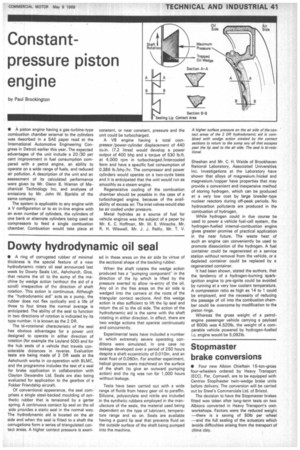Constant
Page 43

If you've noticed an error in this article please click here to report it so we can fix it.
pressure piston engine
by Paul Brockington • A piston engine having a gas-turbine-type combustion chamber external to the cylinders was described in a SAE paper read at the International Automotive Engineering Congress in Detroit earlier this year. The expected advantages of the unit include a 20/30 per cent improvement in fuel consumption compared with a petrol engine, an ability to operate on a wide range of fuels, and reduced air pollution. A description of the unit and an assessment of its calculated performance were given by Mr. Glenn B. Warren of Mechanical Technology Inc. and analyses of emissions by Mr. John W. Bjerklie of the same company.
The system is applicable to any engine with a V configuration or to an in-line engine with an even number of cylinders, the cylinders of one bank or alternate cylinders being used as compressors to feed a single combustion chamber. Combustion would take piece at constant, or near constant, pressure and the unit could be turbocharged.
A V8 engine having a total compressor /power-cylinder displacement of 440 cu.in. (7.2 litres) would develop a power output of 400 bhp and a torque of 530 lb.ft. at 4,000 rpm in turbocharged /intercooled form and have a specific fuel consumption of 0.386 lb/bhp/hr. The compressor and power cylinders would operate on a two-cycle basis and it is anticipated that the unit would run as smoothly as a steam engine.
Regenerative cooling of the combustion chamber should be possible in the case of a turbocharged engine, because of the availability of excess air. The inlet valves would also be air cooled under pressure.
Metal hydrides as a source of fuel for vehicle engines was the subject of a paper by Mr. K. C. Hoffman, Mr. W. E. Winsche, Mr. R. H. Wiswall, Mr. J. J. Reilly, Mr. T. V.


















































































































